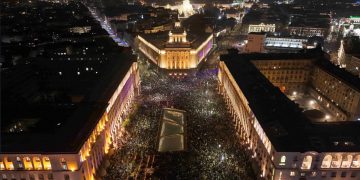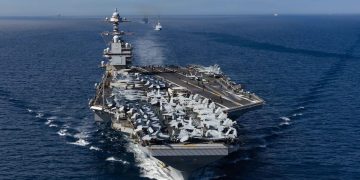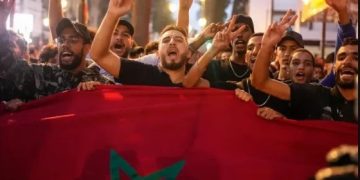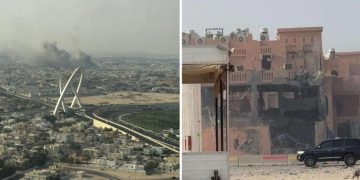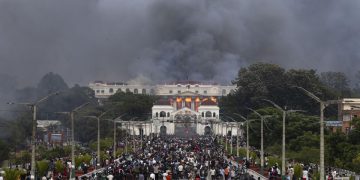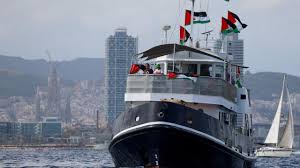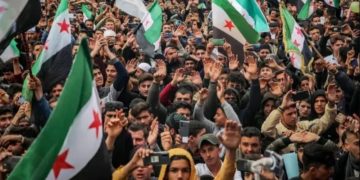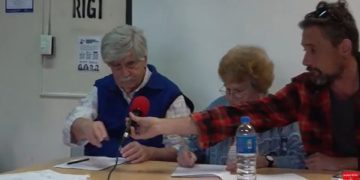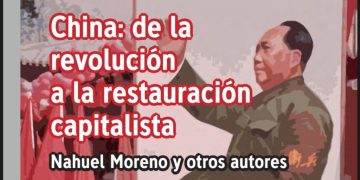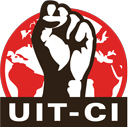Since World War I in 1914-1918, a new historical era opens. The world capitalist system exhausted its prior ability to develop the productive forces and began its decline. The dominance of monopolies and finance capital covered the entire planet. Under this imperialist domination, the bourgeoisie no longer yields gains and improvements for the masses, leaving behind the reformist achievements. Now, the policy of imperialism and monopoly is to search permanently for higher levels of poverty on the masses to try to overcome its crisis, combined with the brake on development of the productive forces.
In this era of crisis, wars and revolutions, the triumph of the socialist revolution in Russia, in October 1917, displayed for the first time the working class as the main protagonist to change the world, launching the era of the international socialist revolution. That is, we define as an era to all this historical period that poses as the only way to save humanity from decadence the triumph of the socialist revolution worldwide. Undoubtedly, every era, which may last hundreds of years, has different stages. It cannot be a historical process always with the same level of balance of power between the classes. So, for revolutionary socialists there have been different historical stages so far. Since the Russian Revolution, we see four major stages.
The first, the stage of the revolutionary offensive of the working class that begins with the taking of power by the Soviets and the Bolshevik Party in October 1917. The Russian Revolution led by Lenin and Trotsky was part of a wave of new revolutions, first in Germany, also in Hungary and Turkey. Bur due to the betrayal of the social democracy and the inexperience of the revolutionary parties of the Third International, the only one which will succeed as socialist revolution is the Russian.
The second, which runs from 1923 to1943, is the stage of the bourgeois counterrevolution, which had already had the first elements with the victory of fascism in Italy in 1922 and which will consolidate clearly with the victory of Hitler in Germany, which crushes the world’s most organized proletariat. Some of the highest points are the defeat of the revolution in China in 1927 and the Spanish revolution in the great civil war of 1936-1939. A key element will be the military offensive of Nazism, successful until 1943, developing the invasion throughout Europe and North Africa. The flipside of this counterrevolutionary stage is the triumph in 1924 in the USSR of the bureaucracy led by Joseph Stalin, after Lenin’s death and the subsequent expulsion of Trotsky. The triumph of what we call Stalinism meant the imposition of a totalitarian dictatorship and the end of workers democracy, although the socio-economic basis achieved by the expropriation of the bourgeoisie remained. The Stalin headed bureaucratic apparatus will produce major policy changes that liquidate the revolutionary character of the Soviet workers state, the Third International and locate the CPSU (Communist Party of the Soviet Union) as the main collaborator of imperialism in the world counterrevolution. The USSR becomes, in the words of Trotsky, a degenerated workers state.
The third is the revolutionary stage that opens from the victory in the battle of Stalingrad of the Red Army against Hitler’s army. This stage, which opens in February 1943 and which will be strengthened with the fall of Nazism in 1945, is a period of great triumphant revolutions. We are talking about a period that goes from 1943 to1989. Anticolonial revolutions triumph and extend the expropriation of the bourgeoisie to a third of humanity, although with bureaucratic regimes. In Eastern Europe, China, the Cuban revolution, the victory of Vietnam in 1974, others as the Portuguese revolution, the liberation of Angola and Mozambique or Iran in 1979. Although with inequalities, all these have been huge successes. Because, logically, this does not negate defeats as the fall of Sukarno in Indonesia in 1965, the triumphs of Pinochet in Chile in 1973, and of the dictatorships in Argentina and Brazil. But the prevailing trend from the fall of Nazism is of great revolutionary upsurge and mass movements that produced revolutionary changes. Unfortunately, this whole stage is tinged with a point of continuity with the previous which is the strengthening of the Stalinist bureaucratic apparatus and reformist and counter-revolutionary leaderships (firstly, the social democracy), which prevented new revolutionary socialist triumphs like Russia in 1917. The new worker states, arising from large revolutionary processes that imposed the expropriation of the bourgeoisie, such as China, Yugoslavia, Cuba and Vietnam, bureaucratized, with all its negative consequences on the workers of the world, remaining as an obstacle to the triumph of a new revolution of October.
The fourth stage is the one opened in 1989, a revolutionary stage, with the fall of the Berlin Wall. Apparently, this would be the same as before. But we talk of a new stage for a qualitatively different point that is the downfall of one-party dictatorships, self-titled «communists» and that was the global pro-Moscow Stalinist apparatus. It is a question, then, of the fall of the biggest counterrevolutionary apparatus. Undoubtedly, this stage has this fundamental point that distinguishes it and makes it a new one, because it opens up a world mass rebellion, what we call political revolution against the old reformist and treacherous leaderships. It has two aspects of continuity with the previous stage: one, a large mass revolutionary upsurge continues; and, two, the crisis of revolutionary leadership of the masses has not been overcome yet, which remains the major task to be done.
The other thing that distinguishes it from the previous stage is that it emerges the leading role of the working class as the root of revolutionary upsurge. Swinging into action some of the heavy battalions of the proletariat, like the Chinese, Russian and European, still lagging behind the U.S. and Japan. But the entry of millions of workers in China, Russia and all Europe is a qualitative leap in the new stage.
The revolutionary upsurge is not a linear process
Of course, that we should talk about a revolutionary stage of the revolutionary process as of 1989 does not mean it is a linear process, without ups and downs or different periods. Nor does it mean that all countries have revolutionary situations. But we are marking the prevailing trend. That in the balance of power what dominates is the rise of the mobilization of the masses, which is the cause of the different phases of crisis that imperialism suffers. Both its military crisis, as well as economic and political. Even the lack of quick improvement in the severity of the crisis is explained by the rise and the resistance of the masses to their adjustment plans. There is a discussion as it may cause confusion when revolutionary socialists speak of a stage and / or of a revolutionary situation in the world when there are sometimes defeats, loss of social and economic gains, which is a reality. But, following Lenin, when we speak of a stage and a revolutionary situation we are referring to that definition of «those above no longer can continue as before and those below do not want to live like before.» It does not mean we are predicting the triumph of the October Revolution, a new Soviet-style victory, immediately. But what we are saying is that the world is open to— due to this relationship between classes, to this new element is the loss of control of a global counter-revolutionary apparatus —any country or any region producing popular rebellions or revolutions that question or topple governments and regimes, but do not come to a new October. And that is what has been happening most clearly with the triumphs of the Arab revolution, the process of labour mobilization, popular and youth in Europe and Latin America. So this is what we mean with a stage and a global revolutionary situation.
Undoubtedly, there are comings and goings. There cannot be a linear process and it is important for us to recognize the ups and downs of the revolutionary process. That is why we can make a periodization since 1989. There is a juncture of triumph of the revolutions against the Stalinist apparatus ranging from 1989-1991, with the fall of the apparatus and party regime of the USSR. In 1991-94 a new period opens of imperialist counter-offensive against the mass movement in the world, which had economic and political triumphs. Among them are, of course, the capitalist restoration in the former USSR, Eastern Europe, China and Cuba; a wave of privatization in many countries, as in Latin America, and higher levels of exploitation. The imposition in many countries of labour flexibility, outsourcing as global system for new forms of exploitation. In other words, significant gains were lost. However, imperialism and the allied bourgeoisies, although participating and leading this counteroffensive, fail to impose a comprehensive defeat of the mass movement, a historic defeat, but this recomposes itself and keeps on fighting.
As of 1994 there is a change from the Chiapas rebellion, a peasant and indigenous rebellion that marks a turning in favour of the masses for its global impact. It will be followed by very remarkable facts as the mobilization in Seattle, USA, in 1999, that started the anti-globalization movement and which will have new expressions with mass demonstrations in Europe. Then comes the new Intifada in 2000. The fall of Fujimori in Peru, Milosevic in Serbia, the «Argentinazo» in 2001 and in April 2002, the defeat of the pro-U.S. military coup in Venezuela, which is a great anti-imperialist democratic victory of Venezuelan and Latin American people.
In 2003 starts a new imperialist counter-offensive with the invasion of Iraq and the defeat of the Iraqi masses. Previously there had been the invasion of Afghanistan. But as every triumph of imperialism at this stage, it has little basis or it backfires as the «law of the mad fire-fighter «, who wants to put out the fire with gasoline. Because this attempt of a new political military counter-offensive of George W. Bush, with the victory of Iraq, the subsequent attempt to impose the FTAA, etc. starts turning in against him causing a chain reaction against the invasion, leading to large mass mobilizations in 2003. In Florence, Italy, comes close to a million people. Also in the Arab countries. And this will culminate in the defeat of the Israeli army in Lebanon in 2006 and in the recognition by imperialism of its failure in Iraq. Then it starts to make an orderly retreat, making Iraq a new Vietnam, in the sense that it becomes a second military defeat of the U.S. imperialist army, the most important in the world.
As of 2007, with the outbreak of the most serious economic crisis of world capitalism, on a par with the crisis in the 1930s, a new world situation opens. There the decay of the capitalist-imperialist system is evidenced. The crisis is so acute that has lasted until now, 2013, unable to be solved. This has also revealed an acute crisis not just economic, but also political and military of imperialism, in the midst of an acceleration of the rise of the masses in the world against the attempt to make the workers and the peoples pay for the crisis of capitalism. With great strikes in Europe, China, Latin America and various parts of the world.
With the triumph of the Arab revolution, from the fall of the dictator of Tunisia in early 2011, Mubarak and Gaddafi in Egypt and Libya, there is a new period of global revolutionary upsurge. Revolution that impacts the masses of the world and it has continuity in the popular uprising against the Syrian dictator and the new workers and popular actions in Tunisia and Egypt. The Arab revolution led to a weakening of imperialism and its partner in the region, Israel. And it has encouraged or excited the peoples of Europe and the world in this revolutionary struggle.
Towards new mass revolutionary confrontations
As a conclusion of this stage, we can say that, on the one hand, the capitalist restoration in one third of humanity, although granted a momentary reprieve to the capitalist crisis, failed to stop the chronic crisis that was going since the 1960s and could not help to enter into a phase of overall worsening of the crisis since 2007. And that would cause the decay in which the whole of Europe and the United States itself are quarrelling. Moreover, what is important is that the new stage shows us the increasing role of the working class against those who predicted its end, because it was said that it was being replaced by technology and robotics. Even for those who bet from the left that it could no longer be a social subject of revolution. China has become a country with 50% of its population as urban and this has shown a phenomenal growth of the proletariat. And they are known, despite all forms of censorship, the heroic strikes and struggles of resistance happening in factories. The same can be said of other Asian countries such as Vietnam, Cambodia, Thailand and Indonesia, where the majority of the multinationals have been implanted thanks to semi-slave labour. In other words, the restoration, both in China and in Vietnam, has had as a point in favour of imperialism that multinationals would regain profits and continue exploiting. But it has had this contradictory point that, linked to the resurgence of the rise of the European proletariat — where general and partial strikes occur that include important sectors of the working class — that makes the process, at this stage of the world revolution after the fall of Stalinism, tend to become increasingly working class and for this to combine with the incorporation and the current role of sectors of the youth, peasants, indigenous, unemployed and exploited in general, indicating the severity of the crisis and the depth of the global rise.
Also the revolutionary processes that finished with the world Stalinist apparatus opened the floodgates to the struggle against the trade union bureaucracies, extended the phenomenon of political revolution, enabling the emergence of class-based currents and movements, although for the moment they are the vanguard. These three central aspects are indicating the existence of a greater chance of fighting to overcome the crisis of leadership in a tough bout against the new and old reformist, neo-reformist and revisionist leaderships.








